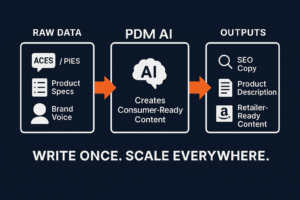As of 2023, approximately 79% of smartphone users have used their mobile devices to make a purchase. – OuterBox
Smartphones have become ubiquitous in our culture. Make it particularly easy to shop, allowing users to store their payment information and easily bounce back and forth between social networking sites or other advertising platforms and eCommerce websites of their favorite brands.
Mobile optimization goes beyond customer demand. Today, it’s a baseline expectation that eCommerce sites are designed for mobile use and offer a simple interface. This is especially true in the automotive aftermarket industry, where enthusiasts expect powerful search tools to help them find the exact part they want, matched to their vehicle’s specific year, make, and model.
Let’s explore why an optimized website should be a key part of your eCommerce strategy in 2024 and beyond.
Trends in online shopping via mobile devices
The trend towards mobile shopping has been accelerating, with a significant portion of e-commerce traffic now coming from mobile devices.
In 2023, it’s estimated that around 79% of smartphone users will have used their device to make purchases. The convenience of shopping on the go and increasingly secure mobile payment solutions have boosted consumer confidence in using their mobile devices for shopping. During key shopping periods like Black Friday and Cyber Monday, mobile sales have consistently set new records, indicating a shift in consumer shopping habits towards mobile-first.
How automotive parts buyers use mobile devices for research and purchases
Mobile devices are crucial in customer interaction, research, and purchasing in the automotive aftermarket sector.
Research indicates that over 60% of automotive parts shoppers use their smartphones at some point in the buying process. This includes initial research, comparing prices, reading reviews, and finally making a purchase. Many users utilize their mobile devices to look up compatibility information while physically in-store or in a garage, underscoring the need for responsive, mobile-friendly websites that provide detailed product information and easy navigation.
Features like QR code scanning, which allows instant access to product manuals or installation guides, can further enhance the mobile user experience for automotive parts buyers who need information quickly.
Benefits of mobile optimization for aftermarket brands and retailers
Improved user experience (UX)
Faster page load times
Mobile optimization significantly improves page load times on mobile devices. Faster loading is critical as mobile users often rely on cellular networks, which may be slower than wired connections. Google reports that 53% of mobile site visits are abandoned if pages take longer than 3 seconds to load. Optimizing images, minimizing code, and leveraging browser caching are all strategies that contribute to faster mobile experiences.
Easier navigation on small screens
Mobile-optimized sites are designed to provide a seamless experience on smaller screens. This involves simplifying the site’s menu structures, increasing button sizes, and ensuring that touch controls are easily accessible. These modifications help prevent user frustration and make it easier for users to find what they need, ultimately reducing bounce rates and improving conversion rates.
Better image and video display
Optimizing visual content for mobile ensures that images and videos are displayed clearly and correctly on various screen sizes. This includes resizing images, using responsive HTML/CSS, and possibly serving different resolutions based on the user’s device. Properly displaying visual content is vital for engaging users, especially when selling products like automotive parts, where details and specifications are important.
Increased customer engagement
Higher interaction rates with optimized content
Mobile-optimized sites see higher levels of engagement as content is tailored to mobile users’ preferences and browsing habits. This can include streamlined content that is easy to read on the go, engaging features like swipeable galleries or interactive sliders, and mobile-specific functionalities such as augmented reality (AR) views of products.
Enhanced features like click-to-call and location services
Mobile optimization allows for the integration of mobile-specific features that enhance user engagement. For example, click-to-call buttons enable users to instantly contact customer service or sales teams without dialing a number. Similarly, location services can guide users to the nearest store or service center, providing a seamless bridge between online and physical experiences.
Enhanced search engine optimization (SEO)
Google’s mobile-first indexing implications
Google now primarily uses the mobile version of the content for indexing and ranking, known as mobile-first indexing. This shift means that websites not optimized for mobile devices may suffer lower rankings in search results, making mobile optimization beneficial and essential for search visibility.
Better search visibility leads to increased traffic
Mobile-optimized sites are favored by search engines and tend to rank higher in search results, particularly for searches performed on mobile devices. This improved visibility can significantly increase traffic to the site. Furthermore, enhanced metadata and structured data can improve how mobile users view the site’s links in search results, increasing the likelihood of clicks.
Key Elements of Mobile-Optimized Websites
Integration with PIM systems
Mobile websites in the automotive aftermarket must integrate effectively with Product Information Management (PIM) systems to ensure that results from a customer’s year, make, and model inputs are accurate and up-to-date.
This integration with ACES and PIES data is critical because it allows for precisely matching parts to specific vehicle configurations, which is a key concern for consumers purchasing compatible aftermarket parts. A robust PIM system directly feeds detailed, accurate data into the mobile site, enabling autofill options and error-free searches. PIM integration enhances user satisfaction by reducing the chances of incorrect purchases and streamlines the inventory management process for businesses. Plus, it ensures that the data displayed on mobile platforms is consistent with what’s available in stock, thereby minimizing discrepancies and boosting efficiency.
Responsive design
Fluid grids and flexible images
Responsive design uses fluid grids that adjust to the screen size, ensuring that layouts are effective regardless of the device. Flexible images scale automatically, enhancing visual appeal and functionality across different devices.
Importance of testing on various devices
Testing on various devices ensures your website performs well on all potential user screens, from smartphones to tablets. This helps identify and fix specific issues related to different operating systems and screen resolutions.
Fast loading speed
Impact of page speed on user retention and conversion rates
Faster websites provide a better user experience, leading to higher retention and conversion rates. Users are less likely to abandon a site that loads quickly, which is particularly crucial for mobile users who browse on the go.
Tools and techniques to enhance loading speed
Tools like Google’s PageSpeed Insights provide valuable insights into how you can improve your website’s loading speed. Techniques such as compressing images, minifying CSS and JavaScript, and leveraging browser caching effectively speed up mobile sites.
Intuitive user interface (UI)
Simplified menus and touch-friendly buttons
An intuitive UI should have simplified navigation menus that make it easy for users to find what they need with minimal effort. Buttons and other interactive elements should be large enough to tap with a finger easily.
Minimized text input and increased use of voice search
Reducing the amount of text users need to input can greatly enhance the mobile experience, particularly on forms. Integrating voice search functionality can provide a faster and more user-friendly way to navigate and search the site, catering to the growing trend of voice interactions in digital devices.
Mobile-Optimized Marketing Strategies for Aftermarket Brands and Retailers
Local SEO optimization
Importance for local aftermarket businesses
For aftermarket businesses with physical locations, local SEO is crucial. It enhances visibility in search results when potential customers are nearby or searching for local services, directly driving foot traffic and local sales.
How to optimize for local search
To optimize for local search, ensure your business is listed accurately on Google My Business and other relevant local directories. Use location-specific keywords in your website’s titles, meta descriptions, and content. Encourage satisfied customers to leave positive reviews online, as these impact local search rankings and trust.
Mobile advertising
Utilizing Google Ads and social media platforms
Mobile advertising should leverage platforms like Google Ads and social media to target users based on location, device type, and browsing behavior. These platforms offer tools to specifically target mobile users, which can help drive more relevant traffic to your site.
Best practices for mobile ad design and placement
Mobile ads should be visually appealing and easily readable on small screens. Keep text concise and include clear calls to action. For placement, ensure ads are positioned where they can grab attention without hindering the user experience, such as in between content feeds on social media or at the top of search results.
Social media integration
Leveraging platforms where automotive enthusiasts gather
Identify and engage with platforms popular among automotive enthusiasts, such as Instagram for sharing images of car parts or modifications or YouTube for how-to videos and product reviews. Tailoring your approach to each platform maximizes engagement.
Creating shareable content and promotions
Develop easy and appealing content to share, like promotions, contests, or educational content about automotive care. Shareable content increases your visibility and organic reach, making it a cost-effective strategy for enhancing brand awareness and customer engagement.
Great aftermarket mobile websites start with effective data management
Are you looking to transform how you manage and distribute your automotive product data?
PDM Automotive is a leading provider of Product Information Management systems designed specifically for the unique demands of the automotive aftermarket. With PDM Automotive, you’ll gain advanced data management capabilities, streamlined operations, and unmatched scalability to foster growth and expansion.
Contact PDM Automotive today to discover how we can turn your product content into your most valuable asset.

More Resources
2024 laws and regulation changes that may affect the automotive aftermarket
What is a PIM and and why it is important for aftermarket brands
Understanding the role of certifications and standards in aftermarket parts quality



